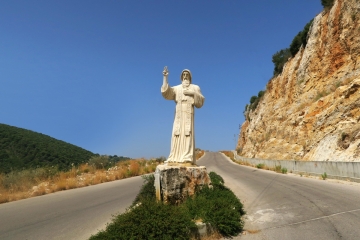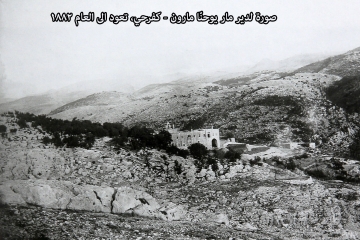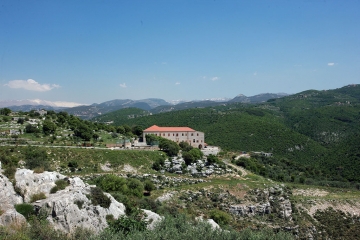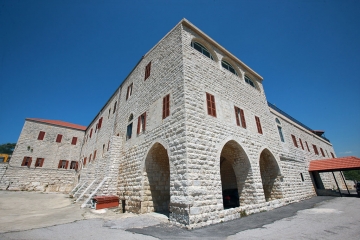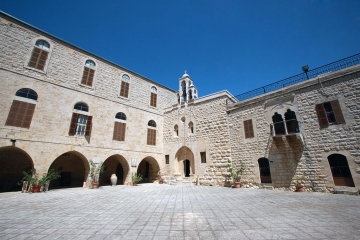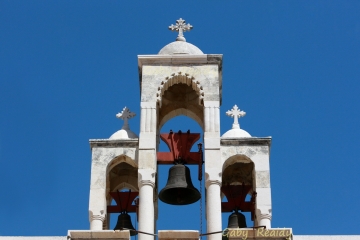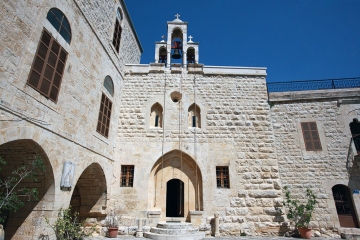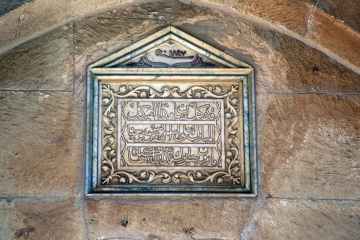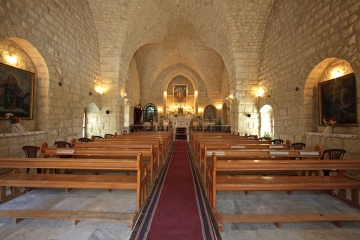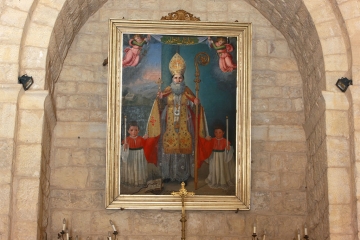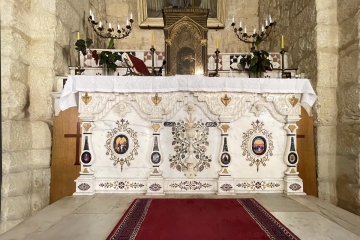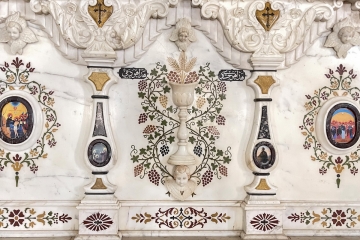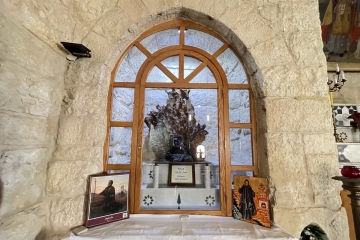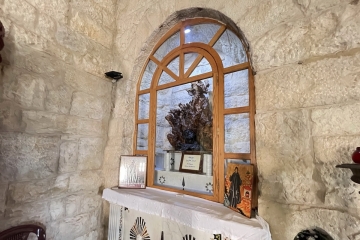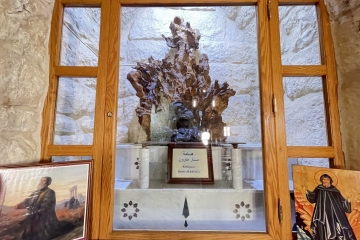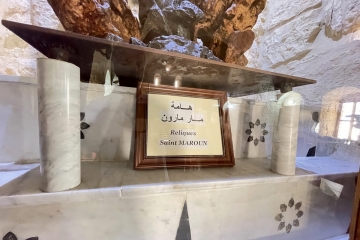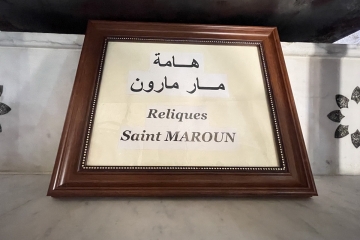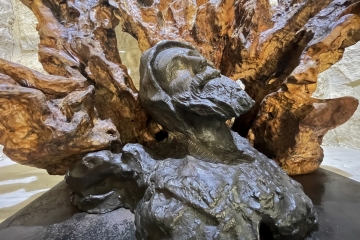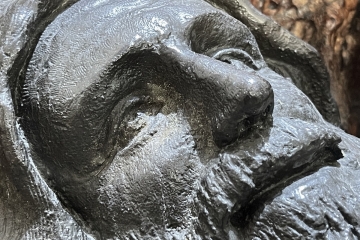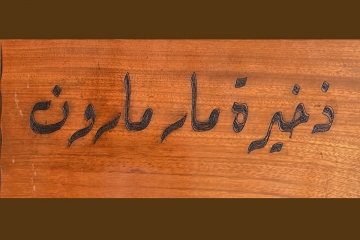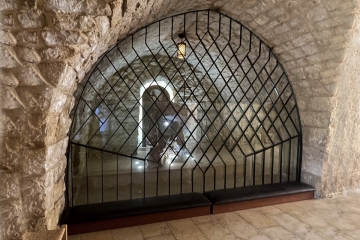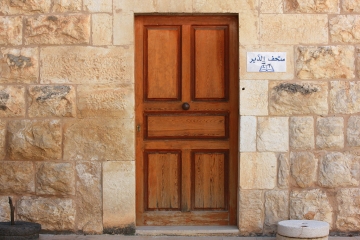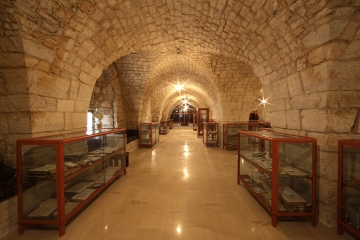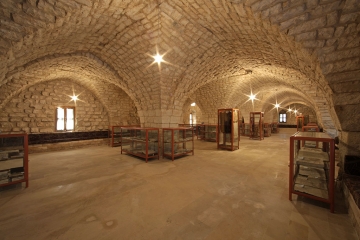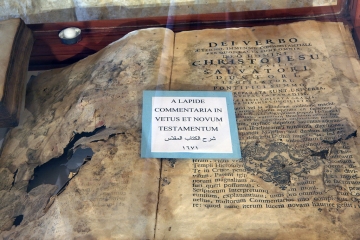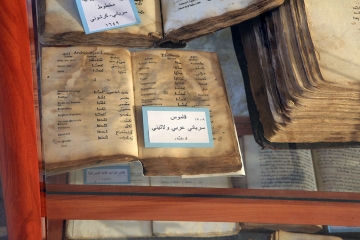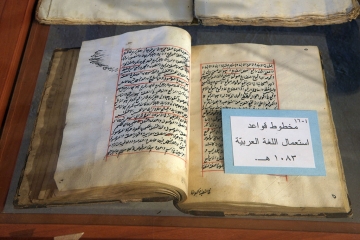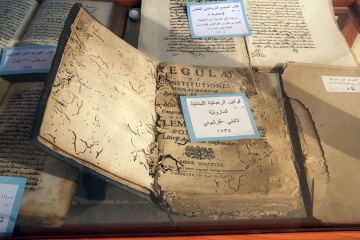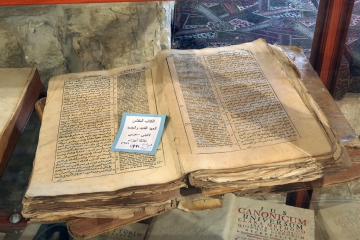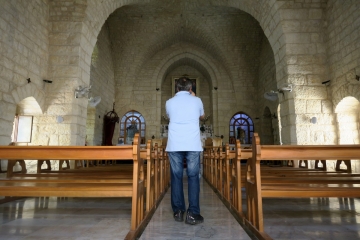دير مار يوحنّا مارون - كفرحيّ
للاطّلاع على تاريخ وسيرة البطريرك يوحنّا مارون الأول باني هذا الدير لا بُدّ من الرجوع إلى ما توفّر عنه في المخطوطات القديمة.. التي تستند إليها المؤلفات الحديثة التي عُنيَ بتأليفها كهنة أعلام باحثون ومحققون. ففي نبذة عنه بعنوان: "حياة القديس يوحنا مارون البطريرك الأول على الطائفة المارونية" نقرأ: "أن القديس يوحنا مارون كان البطريرك الأول على طائفتنا". وتتابع قائلةً أنّه بعد موت تاوافان، البطريرك الثاني والسّتّين بعد القديس بطرس على مدينة أنطاكية، أقيم يوحنّا مارون السّرومي في مقامه، وذلك في القسم الثاني من القرن السابع اي نحو سنة 685.
وقد أجمع التقليد والتاريخ على أن القديس يوحنا مارون من أصلٍ شريف، اسم أبيه اغاتون وأمه أنوهاميا. وكان أغاتون إبن اليديس المتصل نسباً من جهة والدته بملوك فرنسا، لذلك إشتهر عن يوحنّا انه إبن الإفرنج. وقد عُرف باسم السَّرومي نسبةً إلى سَرّوم لأنه وُلدَ فيها، وهي قرية كبيرة في جبل السويدية بالقرب من أنطاكيا.
وفي التفاصيل أن يوحنا مارون وُلد سنة 627 في بلدة سرّوم في جبل السويدية، وقد سُمّي "يوحنا"، على ما يذكر الدويهي، لولادته في يوم تذكار القديس يوحنا صابغ الرب الواقع في ثاني الدنح (أي الغطاس)، وسُمّي "مارون" لأنه لبس إسكيم الرهبانية في دير القديس مارون الذي يقع في سوريا الشمالية في جوار جبل الزاوية.
على أنّ أهمّ ما يعنينا من هذه النبذة هو ما يتعلّق بسيامته أسقفاً على البترون، وهو ما أدّى إلى بنائه دير كفرحي. فقد ورد فيها أن البرنس أوجان والإفرنج المُقيمين في أنطاكيا اجتمعوا وقَرَّ رأيهم على إقامة مطران يكون من جهة كنيسة رومية، فاتفقوا على سيامة يوحنّا السَّرومي لما كان يبديه من ضروب الغيرة وأنواع العلم والتقوى، فحملوا به إلى الكردينال الذي رَسَمَه أسقفاً على البترون وسكان جبل لبنان.
ولما كان جيش موريق وموريقيان قد دَكَّ الدير الذي كان يقطن فيه مار مارون في سوريا إلى الأرض وقتل رهبانه، وكان يوحنّا من الناشرين لواء فضائله السّامية وأعماله الشريفة (الضمير يعود إلى القديس مارون) فقد أقام ديراً آخر على اسمه الكريم شرقيَّ كفرحيّ من أعمال البترون، ثم نَقَل إليه هامَتِه المُقدّسة من سوريا وأقام له عيداً في الخامس من كانون الثاني.
هذا عندما كان يوحنّا مارون أسقفاً على البترون، إذ توضِح ما ورد أعلاه نَشرة عن هذا الدير بعنوان: "دير مار يوحنّا مارون - كفرحيّ"، فقد ورد فيها: "بَنَى البطريرك الماروني الأول يوحنّا مارون، لمّا كان مطراناً على البترون، ديراً في كفرحيّ ليكون إستمراراً لدير مار مارون على العاصي الذي قُتل رهبانه وتبعثرت محتوياته، وبعد إنتخابه بطريركاً (685-707) اتّخذ له كرسيّاً في هذا الدير ونقل اليه هامة (اي جُمجُمة) أبينا مارون وسَمّاه "دير ريش موران" أو "رأس سيّدنا" (مارون) نسبةً إلى هذه الذخيرة الثمينة".
أمّا لماذا دَكَّ جيش موريق وموريقيان دير مار مارون في سوريا فنقرأ أسبابه في كتاب "مدرسة دير مار مارون – كفرحي" للدكتور جان نخول الذي جاء فيه: "وقع الاختلاف بين البطريرك يوحنا مارون وبين ملك القسطنطينية حول طبيعة السيّد المسيح، مِمّا اضطر البطريرك إلى التوجه نحو دير القديس مارون على نهر العاصي.. لكنَّ جَيشَ الملك تقدَّم نحو سورية سنة 694 وهَدَم دير القديس مارون وقَتل رهبانه بالمئات، ولاحق مَن يقول بالطبيعتين والمشيئتين في السيّد المسيح، وتابع سيره حتى مدينة طرابلس... فرأى البطريرك أن يُنشئ ديراً آخر على اسم الدير المُهدَّم، "شَرقيّ قرية كفرحي من عمل البترون، ونقل إليه هامته (هامة القديس مارون)، وعَيَّن له عيداً في الخامس من كانون الثاني". هذا عن تاريخ بناء دير مار يوحنا مارون كفرحي.
أتينا على ذِكر هذا كُلّه لأنه يَتَضارب مع ما جاء لدى الأب انطوان ضو الأنطوني حول "مراكز البطاركة الموارنة" إذ يقول: "التقليد الماروني يقول أن البطريرك القدّيس يوحنّا مارون الأول هو أول بطريرك ماروني وقد سَكن في كفرحيّ، على أن الابحاث التاريخية الحديثة، تُبرهِن على أن أول بطريرك ماروني أقام في لبنان هو البطريرك يوحنّا مارون الثّاني وليس يوحنّا مارون الأول". ونحن لا نَذكُر ذلك لنقف عند مسألة أيّهما من الاثنين كان الأول في مجيئه إلى لبنان، بل لأن الأب ضو يقول أنه إلى يانوح لجأ البطاركة الموارنة بعد نزوحهم من سوريا وأقاموا فيها من سنة 949 إلى سنة 1121، وعددهم يفوق العشرين بطريركاً، أولّهم يوحنّا مارون الثّاني وآخرهم يوسف الجرجسي.
هنا تقوم إشكالية جديدة، لأن ما تقدّم مِمّا ذكرنا عن بناء دير مار يوحنّا مارون في كفرحيّ إنه بناه البطريرك يوحنا مارون عندما كان أسقفاً على البترون، ثم اتّخذ له كرسيّاً فيه بعد انتخابه بطريركاً. ولمّا كان هو البطريرك الأول وقد أقام في دير كفرحيّ فمعنى ذلك ان هذا الدير كان المقرّ البطريركيّ المارونيّ الأول، خِلافاً للقول أنه إلى يانوح لجأ البطاركة الموارنة بعد نزوحهم من سوريا، فيكون أول كرسيّ بطريركي ماروني في لبنان، تبعاً لذلك، في يانوح وليس في كفرحي.
ويَستَنِد الأب ضو، كما ذكرنا سابقاً، في قوله هذا إلى البطريرك الدويهي في كتابه: "تاريخ الأزمنة" الذي جاء فيه: "في هذه السنة 327 هـ (949 م) كانت نقلت (نقلة) البطريرك يوحنّا من أنطاكيا إلى جبل لبنان. ثم أنه قَصَد زيارة القُدس الشريف والمواضِع المُقدّسة فلم يتركه المُسلمون، بل أنه مضى إلى يانوح".
ولكن هذا الكلام مَردود بِكليّته إذ لا أثر له في "تاريخ الأزمنة" للدويهي الذي يبدأ في التأريخ إعتباراً من العام 1095 للميلاد وحتى العام 1699، بينما تلك النقلة المَنسوبة إليه حصلت قبل بدء الدويهي بتاريخه بمئة وست وأربعين سنة. ("تاريخ الأزمنة"، طبعة مجلة "المشرق" سنة 1950-المطبعة الكاثوليكية – بيروت، 1951)
هذا بينما يقول الدويهي نَفسَه في ما ذكره عن "سِلسِلة بطاركة الطائفة المارونية": "في سنة 685 للميلاد الإلهي كان الكرسيّ البطريركيّ في دير القدّيس مارون في قرية كفرحيّ من أعمال البترون، وقد أقام فيه ثلاثة من البطاركة وهم يوحنّا مارون وكيروس وجبرائيل، ثم نُقل بعد البطريرك جبرائيل المذكور إلى سيّدة يانوح في أبرشية البترون نفسها حَيثُ استمرَّ إلى سنة 1120.. بعد أن تعاقب عليه عشرون بطريركاً أوّلهم يوحنّا الثاني المعروف بمارون وآخرهم يوسف الجرجسي". وكذلك، استناداً إلى "سِلسِلة البطاركة الموارنة" للدويهي، فإن بطريركاً رابعاً جلس ايضاً لفترةٍ في دير مار يوحنا كفرحي هو دانيال الشاماتي.
فَمِن كلام الدويهي هذا نَستنتج أن مَن سكن دير كفرحيّ هو يوحنّا مارون الأول، ومَن سكن دير سيّدة يانوح هو البطريرك يوحنّا مارون الثاني. ومار يوحنا مارون الأوِّل هذا لم يَكن زعيماً وطنياً فحسب، بل كان أيضاً قديساً جاهداً في مهمته الرسولية، إذ أنه عَلَّم وبَشَّر وزار أبناء أبرشيته خصوصاً خلال الفترة التي إنتشر فيها وباء الطاعون. وله أيضاً في رتبة القداس نافور على اسمه، كما أنه ألَّف كتاباً عن العقيدة اللاهوتية. وقَد سَمّاه البطريرك بشارة بطرس الراعي عام2011، خلال عظة تولّيه السدّة البطريركية، "البطريرك الماروني الأول القديس يوحنا مارون، الذي ثَبَّتَ الكنيسة المارونية على العقيدة الكاثوليكية، وجَعَلها أُمة مُستقلة بحكمها الذاتي في جبل لبنان".
وفي هذا المقام لا بُدّ من ذكر أن قورش، البطريرك الثاني، هو ابن أخت البطريرك يوحنا مارون، وقد ذكرت مجلة "المشرق" في سنتها الأولى عام 1898 أن هذا البطريرك "بعث، كما هو مُحَرَّر في قصة خاله، فطلب التثبيت من صاحب الكرسيّ الروماني، وساس قومه سياسة الأبرار إلى آخر حياته." وقد ذكر عنه البطريرك بولس مسعد في سِلسِلته التي تحمل عنوان: "بخصوص البطريرك الماروني ورئاسته على مدينة أنطاكية": "وقام من بعده بطريرك اسمه كوروش او كوريوس على كرسيّ انطاكية، وقد ثبَّته بابا روميه وأرسل له درع التثبيت (الباليوم) ، ومنذ ذاك الزمان إلى وقتنا هذا ما زال رؤساء الآباء يلبسون الدرع والتاج والخاتم على زي كنيسة روميه".
وبِمُناسبة الحديث عن درع التثبيت (الباليوم) لا بُدّ من التوقف عنده لإيضاح ماهيته وتاريخ العمل به في الكنيسة، لنتابع من ثم الحديث الذي كنا فيه عن تاريخ كفرحي... إنه شريط من الصوف الابيض يناله البطاركة ورؤساء الأساقفة من البابا رمزاً لشركتهم معه وسلطتهم كرُعاة مُهمَتِهم السهرعلى قطيع الربّ. وهي، من بين شعارات الحبر الأعظم، الأكثر تعبيراً، وتُسمىّ "درع البطاركة والمطارنة"، وتفصيلها أنها نسيج صوفيّ أبيض يرسله خليفة بطرس إلى البطاركة ورؤساء الأساقفة والقُصّاد الرسوليين دلالةً على السُلطة التي تُخوّلهم إياها هذه الدرع في كنائسهم. فهو يشير إلى "الراعي الصالح"، وإلى الحَمَل المصلوب من أجل خلاص البشرية، كما أكد ذلك البابا بندكتس السادس عشر (2005-2013) في موعظة له إذ قال: "إن صوف الحَمَل يعني التعبير عن النعجة الضالَّة، أو تلك التي هي مريضة او ضعيفة، التي يضعها الراعي على كتفيه ويقودها إلى ينابيع الحياة".
والآثار التاريخية الأولى للباليوم تبدأ منذ الأجيال الأولى للمسيحية، بينما هناك مَن يؤكد أن الباليوم يأخذ أصوله من ثياب ضباط الدولة الرومان قبل أن يلبسه أصحاب المقامات الحبرية. وعلى كُلّ حال فهو كان في أوآئل عهد النصرانية شبه كِساء يشتمل به الأساقفة عند إقامتهم الرتب الكنسية، ثم طرأت على هيئته اختلافات عديدة مع مرور الأيام إلى ان صار على الشكل المعهود في أيامنا. وهو من الصوف، وصوفه مأخوذ من جزَّة حَمَلين أبيضين يقدّمهما قانونيو كنيسة القديس يوحنا اللاتراني كل سنة للحبر الأعظم. فإذا وافى يوم عيد القديسة الشهيدة أغنس في 21 كانون الثاني يُزيَّن الحَمَلان بالأزهار ويُحملان إلى الكنيسة الملكية المبنية على اسم هذه الشهيدة ويُجعلان وقت القدّاس على وسادتين من المُخمَل الأحمر على جانبَي الهيكل، ثم يتلو عليهما كردينال القديسة أغنس صلواتٍ معلومة يطلب فيها من الله أن يَعضُد الذين يلبسون الدِرع المنسوجة من صوفهما.. ويرشُّهما بالماء المقدَّس، ثم يُحملان إلى الحبر الأعظم فيباركهما، ثم يسلّمهما شمّاسان إلى راهبات القديس لورنسيوس.. فيقمن برعايتهما وتربيتهما، ثم يُجَزّ صوفهما يوم خميس الأسرار.. ويُنسج دروعاً تُصان في خزانة القديس بطرس إلى بيرمون عيده حيث يؤتى بها إلى عظيم الأحبار، فيكرّسها ويودعها محافظ ثمينة ويجعلها على قبر هامة الرسل منذ مساء اليوم السابق لعيده.. فتبقى هناك إلى ثاني يوم العيد، ولذلك يقال إنها أُخذت من جسم القديس بطرس. وهي عبارة عن قُدَّة عرضها ثلاث اصابع تُجْمَع حول العنق فتطوّقه. ولهذا الطوق طرفان.. ينزل أحدهما على الصدر والثاني على الظهر.. ويزيّنهما صلبان سود. وهذه الطريقة في لبس الباليوم استمرَّت حتى نهاية القرون الوسطى عندما أصبحوا يستخدمون الدبابيس لِجعل طرفَي الباليوم يتدلّيان إلى منتصف الصدر والظهر تماماً. ثم إستُعيض عن الدبابيس بالخياطة الثابتة، فتوصَّلوا بهذه الطريقة إلى الشكل الدائريّ المُغلَق الذي بتنا نُصادفه عادةً بعد القرن التاسع..كما يظهر في احتفالات بعض الكنائس الرومانية الكبيرة. وظَلَّ طرفا الباليوم مُحتفظَين ببعض الطول إلى أن تمَّ تقصيرهما بعد القرن الخامس عشر.
وكانت هذه الدِرع المُقدسة في أوآئل عهد الكنيسة من الملابس الحبرية، ثم أخذ البابوات منذ القرن الرابع يمنحونها لمن يريدون إكرامه. وهي تُلبَس، مبدئياً، في كنيسة الكرسيّ البطريركيّ، في احتفال يحضره مطارين الطائفة، وعلية الإكليروس، والشعب، وأصحاب المقامات العالية وأهل النبل، ولم يكن مُعتَرَفاً بشعار الباليوم ما لم يكن ممنوحاً من قِبَل الحبر الأعظم نفسه.
هذا في ما يتعلَّق بدرع التثبيت، ونعود إلى البطريرك الدويهي في "سِلسِلة بطاركة الطائفة المارونية" لنقع فيها على نص يختلف قليلاً عما سبق اذ يقول:
"في ذلك العَصر كان جالساً على تَخْتْ مملكة الروم يوستينيانوس الأخرم، فأطغاه عدوّ الخير حتى استمال عقله إلى زعم رؤساء الكهنة المُتمَسكين بمشيئة واحدة، فأنشأ الإضطهاد على البابا سرجيوس (687-701) صاحب الكرسيّ الروماني، ولأجل ذلك إضطر البطريرك يوحنا أن ينتقل من أنطاكيا إلى دير مار مارون الذي في سورية على نهر العاصي ومن هناك إلى سمار جبيل".
وليست مسألة مّن هو البطريرك الماروني الذي جاء أولاً إلى لبنان: يوحنّا مارون الأول أم يوحنّا مارون الثّاني هي وحدها موضع خلاف، بل أن شخصية يوحنّا مارون الأول تحوم الشكوك حول حقيقة وجودها. فقد شَكَّ بعضُ المؤرخين في أن يكون يوحنّا مارون أول بطريرك ماروني، وأول هؤلاء المؤرخين الفرنسي رينودو (1646-1720) الذي استند في نفيه وجودَهُ إلى أنه لم يرد له ذكر في جداول البطاركة الإنطاكيين التي لدى اللاتين والروم. وقد ردّ عليه المُحقق الأب إميل إده بأن الكنائس المُختلفة لم تَكُن جداولها تَتَضَمّن أسماء غير بطاركتها. فليس في مُصنّفات الكنيسة اللاتينية او اليعقوبية او النسطورية او البيزنطية إلا ذكر بطاركتها، وهذا لا يعني عدم وجود غيرهم في الكنائس الاخرى. ويُضيف الأب إده انه لم يكن معقولاً أن يندرج اسم يوحنّا مارون ضمن الجدول الرسمي للبطاركة الانطاكيين لسبب ان انتخاب البطريرك الماروني تمّ خلافاً لإرادة الملك البيزنطي، فلم يُدرَج اسمه في جدول البطاركة الرسمي لأن هذا لا يحتوي إلا أسماء الموالين للأمبراطور.. وخصوصاً الأمبراطور يوتينيانوس الثاني الذي إشتهر بعداوته اللَدودَة للموارنة، فلا يُعقل أن يرد اسم بطريركهم الأول في الجدول الرسمي مع الموالين له.
وبالمقابل فان "الموسوعة الحُرّة" عن الكنيسة المارونية لا تَتَضَمَّن أية معلومات تتحدّث عن البطاركة الموارنة في فترة الحكم البيزنطي والأموي، إلا أنه من المعروف انهم أقاموا في دير سيّدة يانوح في قضاء جبيل اللبناني. حتى إن شخصية يوحنّا مارون وبطريركيته لا تتوافر أدلة موثوقة عنها. هناك مرجع وحيد يسمّيه الدويهي "مُعتَقَد اليعاقبة" يَذكُر شخصاً باسم يوحنّا مارون كان أسقفاً على البترون التي تحتوي دير ريش مورو.. تلقّى رِسامته على يد مبعوثٍ بابويّ إلى المشرق. لكنَّ ما يزيد الأمر تعقيداً، تتابع الموسوعة، هو تضارب روايتَي البطريرك الدويهي والسمعاني، وهما من كبار المؤرخين الموارنة، في سيرتهما حول بطريركية يوحنّا مارون، فلا يسع، في ظلّ غياب المراجع والوثائق وتضارب الروايات، إلا القول بأن الموارنة تولّوا شؤون الكرسيّ الانطاكي أوآخر القرن السابع على الأرجح، وكان أول مَن تسلّم زمام هذا الكرسيّ يوحنّا مارون.
كل ما ذكرناه حتّى الآن يتعلّق بسبب بناء دير مار يوحنا مارون – كفرحي ومَن هو الذي بناه، وهل كان هو المقرّ البطريركي الماروني الأول أم سواه. أمّا في ما يَختص بالدير بحدِّ ذاته، وبما طرأ على هامة القديس مارون التي كانت فيه، وما لَحِقَه من الخراب أو الهدم في القرون التالية وإعادة ترميمه او بنائه من جديد، ثم عن هيكلية هذا الدير ومُحتوياته والمدرسة التي قامت فيه من بعد، فإننا نقول إنه في العام 1130 حمل الصليبيون ذخائر القديس مارون من هذا الدير في كفرحي إلى روما، وقد حُفظت بعناية إلهية حتى العام 2000 حين عادت إلى دير كفرحي بطلب من البطريرك الماروني مار نصرالله بطرس صفير الذي قال: "الذخيرة أُخذت من دير كفرحي وإليه تعود".
وفي العام 1812 قرر المجمع البطريركي برئاسة البطريرك يوحنا الحلو ( 1809-1823) تحويل هذا الدير إلى مدرسة لتنشئة الكهنة، وكانت تُعلّم سبع لغات إضافةً إلى مختلف العلوم والآداب، والوثائق تُثبت ذلك، ومن ثم أضحَت تَستقبِل تلامذة موارنة عِلمانيين من مَختلف مناطق جبيل والكورة وجبّة بشرّي. وكانت أتعاب المعلّمين عبارة عن غلال الأرض يُقدّمها الأهل للمدرسة. وكانت تُخَرِّج تلامذة يُرسَلون إلى المدرسة المارونية في روما. وهي المدرسة النظامية الثانية بعد مدرسة عين ورقة لناحية الأهمية العلمية الكبرى، وقد خَرَّجَت عُظماء مثل البطريركين الياس الحويك (1899-1931) وأنطون عريضة (1932-1955)، وكان القُنصل الفرنسي في طرابلس يَحضُر في آخر كل سنة مدرسية حفل التخرّج فيها.
وقد مرّت على هذا الدير مراحل عديدة نقرأ بعضاً منها في كتاب "المُحاماة عن الموارنة وقدّيسيهم" الذي يقول أن دير مار مارون – كفرحي قد دُمّرَ كلّياً بحيث لم يَعُدْ يُعْرَف مكان وجوده بالضبط، ولا مكان دفن القديس يوحنا مارون فيه.
ويذكر هذا الكتاب أن الدير كان قائماً في العهد الصليبي، وكان من أهم الأديرة السورية المارونية في كونتية طرابلس في القرنين الثاني عشر والثالث عشر. ويتحدث الأب يوسف حبيقة عن هذا الدير فيقول:"حوالي سنة 1287 كان هذا الدير مركزأ للبطريرك الماروني، وفيه اجتمع مقدَّمو الموارنة لإقامة مُقدَّم لهم بدلاً من المقدَّم سالم الجانح إلى اليعقوبية.. فعزلوه، وهذا الحَدث يُثبت زعامة البطريرك الماروني المدنيّة أيضاً على شعبه".
ويُروى أنه في عهد المماليك، زمنَ الأشرف خليل (1290-1293)، تَمَّ تجريد حملة على كسروان في صيف سنة 1291 وعلى رأسها الأمير بدر الدين بيدرا وهو في ذلك الوقت نائب السلطنة في مصر، وتفيد زجلية ابن القلاعي بأن المماليك هُزموا على يد المقدّمين الموارنة.. الذين تجمَّعوا بعد إنتصارهم في قرية كفرحي.
أمّا كيف تحوَّل الدير إلى اسم القديس يوحنا مارون، فتفصيله أنه لدى زيارة البطريرك يوسف اسطفان ( 1766-1793) الرعائية لأبناء رعيّته في بلاد البترون بعد عودته من الكرمل، إستوقفته أطلال الدير الذي تعرَّض للتخريب على يد بني سَيفا، إذ لم يَجد حيث كان سوى آثارٍ دارسة وأطلال طامسة. فحرَّكته الغيرة الدينية على إرجاعه إلى رونقه القديم قبل هدمه في العام 1634. ولكنَّ من المُتداول هو أن الدير الحالي لا يقوم في المكان ذاته الذي كان يقوم فيه الدير الذي بناه البطريرك الأول، بل في بقعة غير بعيدة عنه. فوَجَّه إليه القَسّ يوسف الحدّاد من دلبتا والقسّ الياس من ريفون ليعتنيا بتجديده. هذا ما أشار اليه المؤرخ الأب لامنس، أمّا البطريرك يوسف الخازن (1845-1854) فيُشير في إحدى رسائله إلى المجمع المُقدَّس، المؤرخة في 24 نيسان 1850، إلى ترميم هذا الدير بقوله: " لما تولّى الأمير يوسف الشهابي على بلاد البترون وحصل هدوء فيها نوعاً ما اعتنى البطريرك يوسف اسطفان بترميم كنيسة هذا الدير، وجَدَّد فيه بعض المساكن، ووضع فيه كاهناً يُسمّى القس يوسف الحدّاد من قرية دلبتا في كسروان.. وَوَكّله به مع الأرزاق التي كانت باقية له، وأخذ يُجدّد له أملاكأ وأمتعة".
فإزدهر الدير وكثر رهبانه مع الأيام كما تُشير نبذة بعنوان: "دير مار يوحنا مارون – كفرحي الحاوي ذخيرة مار مارون".. التي تتابع: "وقد ظَلَّ قائماً إلى ما بعد العهد الصليبي، واجتمع فيه مقَدَّمو الموارنة أكثر من مرة ليتدارسوا شؤون الطائفة".
وتستطرد النشرة: "تعرَّض الدير للتخريب والسلب والنهب والتدمير أكثر من مرة في العهد العثماني بفعل تبدُّل الحكام وجور الايام، وفي كل مرة كان يعاد بناؤه ليتابع نشاطه الروحي والثقافي والحضاري والوطني. وفي أوآخر القرن الثامن عشر أمر البطريرك يوسف اسطفان بإعادة بنائه بعد أن كان خراباً، وبَدَّل اسمه من دير "ريش موران" إلى دير مار يوحنا مارون".
وهناك وثيقة محفوظة عند آل فريفر في منزل القاضي رزق الله فريفر مؤرخة في 16 آب 1787 وموقّعة من البطريرك يوسف اسطفان.. تحمل في طياتها تاريخ تحويل اسم الدير: "هذا الدير والمقام المبارك يتسمّى ويقام باسم أبينا القديس مار يوحنا مارون دون غير". ويذكر الخورأسقف يوسف داغر التنوري أن البطريرك يوسف اسطفان (1766-1793) قد حَوَّل كنيسة مار مارون إلى اسم يوحنا، وذلك عند إعادة بناء الدير سنة 1787.
واستمرت المدرسة في تقدُّمها مع المونسنيور بطرس إرسانيوس. وتوقفت أثناء الحرب العالمية الأولى، ولكنها فتحت أبوابها أمام المحتاجين من أبناء المنطقة ولبنان، وكانت تُقدِّم شهرياً آلاف الوجبات من الطعام. ثم عادت بعد الحرب مع المطران الياس شديد، ولكن بِتَعثُّر نظراً لفراغ المنطقة من السكان. وسنة 1950 فتحت أبوابها لتصبح مدرسة إكليريكية للدعوات المُتأخرة وتُخَرَّج منها أكثر من مائتين وخمسين كاهناً.. إلى أن أُقفلت نهائياً في مطلع السبعينات.
وقد ذكرنا سابقاً كيف انتقلت ذخائر القديس مارون من هذا الدير إلى إيطاليا ثم عادت اليه في العام 2000، ولكننا هنا نختم استعراض المراحل التاريخية التي مرَّ بها الدير بالتحدث تفصيلاً عن "رحلة" هذه الذخائر إلى الغرب وعودتها إلى قاعدتها سالمة.. فنقول، نقلاً عن نشرة "دير مار يوحنا مارون- كفرحي الحاوي ذخيرة مار مارون" : "بعد الانتهاء من ترميم الدير راح سيادة المطران بولس إميل سعادة يهتم بإستعادة ذخيرة مار مارون. ويروي التقليد الماروني والمؤرخون الموارنة، كالبطريرك اسطفان الدويهي والمطران يوسف سمعان السمعاني والمطران يوسف الدبس والأباتي بطرس فهد، أن الراهب يوحنا مارون، الذي أصبح مطراناً على البترون ثم البطريرك الماروني الأول، نقل معه "جمجمة" مار مارون من ديره على العاصي إلى كرسيّه في كفرحي، إلى الدير الذي أطلق عليه اسم "دير ريش موران"، و"صمد" فيه رأس القديس مارون ليتبالغ المؤمنون في تكريمه ويستشفعوه ويلتمسوا دعاءَه وصلاته إلى الله".
وتتابع النَشرَة:"ويروي المؤرخ الإيطالي لودوفيكو جاكوبيلي، وهو من مدينة فولينيو، ان الأب ميشال البنديكتاني، من أمراء أوبيلو، لما كان رئيساً لدير الصليب في منطقة ساسوفيفو (قرب فولينيو)، ذهب سنة 1130 لزيارة الاراضي المُقدَّسة، وحصل، بنعمة خاصة، من الرهبان الذين كانوا يحرسون دير رأس مارون، على هامة القديس وحملها بكل إكرام ووضعها في كنيسة ديره حيث جرت بشفاعته (القديس) عجائب وشفاءات كثيرة. وسنة 1490 أمر مطران فولينيو بنقل الذخيرة إلى كاتدرائية فولينيو حيث تُعرَض كل سنة في العاشر من آذار على المؤمنين لتُكرَّم بتطواف في شوارع المدينة. وسنة 1998 إتصل المطران سعادة بمطران فولينيو، أردينو برتولدو، ليخبره عن رغبته في استعادة ذخيرة مار مارون، فوافق هذا الأخير بعد استشارة الكرسيّ الرسوليّ وأرسل الذخيرة إلى لبنان في الحقيبة الديبلوماسية الفاتيكانية. وفي 8 كانون الثاني 2000 نُقلت الذخيرة إلى كرسيّ مطرانية البترون في كفرحي حيث أقيم إحتفال كبير ترأسه غبطة البطريرك الكاردينال مار نصرالله بطرس صفير.. وأُودعت في كنيسة مار يوحنا مارون". وهذه الذخيرة موضوعة على المذبح الأيسر العائد لكنيسة الدير ، وذلك ضِمنَ مَنحوتة فنّية من خشب الزيتون من أعمال الفنّان رودي رحمه.
ويُدعى هذا الدير اليوم "دير ومدرسة مار يوحنا مارون – كفرحي"، ويقع في قرية كفرحي التابعة لقضاء البترون، والتي تبعد خمسة عشر كيلومتراً عن مدينة البترون مركز القضاء، كما تَبعد إثنين وسبعين كيلومتراً عن العاصمة بيروت، وترتفع أربعمئة متر عن سطح البحر. وأصل تسمية هذه القرية باللغة السريانية وتعني "قرية الحيّ والعائش" أي الإنسان المُتمتّع بالحياة.
يتألف الدير من مقر لمطران أبرشية البترون، وكنيسة، ومدرسة ومتحف، ويعلو مدخل الكنيسة منحوتة نقرأ عليها:
"سنة 1847
قد كمل بنيان هذا الهيكل
المبارك على اسم القديس يوحنا
مارون بطريرك مدينة الله انطاكية".
الكنيسة مَبنية بِالعقد على طريقة الصروح والبيوت اللبنانية القديمة، تَتَصدّرها صورة القديس يوحنا مارون بريشة الرسّام داوود القرم، وهي بقياس 200 -300 سنتم، حيث يبدو فيها باللباس الحبري مع العصا والتاج، وتعلوها عبارة "مجد لبنان أعطي له"، كما خُطَّت في أسفلها العبارة التالية: "حناجرهم قبور مفتَّحة، وسُمُّ الافاعي تحت شفاههم".
أمّا بالنسبة إلى المدرسة القائمة في الدير فَنَستقي المعلومات عنها من كتاب "مدرسة دير مار يوحنا مارون-كفرحي" للدكتور جان نخول، الذي يقول انها تأسست بموجب وثيقة خطية صادرة عن البطريرك يوسف اسطفان، ممهورة بتوقيعه ومؤرخة في 16 تشرين الأول سنة 1787، وفيها: "أذنّا لهم (أي لمشايخ آل فريفر أصحاب قرية كفرحي) ان يُلَفّوا اليه (أي إلى الدير) كهنةً ورهباناً يقوموا بخدمة الله، ويقيموا به مدرسة من أجل تعليم الأولاد: أولاد قريتهم، ومن الجيرة".
أمّا تأسيس المدرسة فعلياً فقد جرى بناءً على وثيقة مؤرخة في 15 آب سنة 1812، وقد جاء فيها ان المطران جرمانوس تابت، مطران جبيل والبترون، قد ألغى المكانة الفريدة لآل فريفر على دير مار يوحنا مارون. كما جاء في بعض قوانين التأسيس " إن المدرسة المذكورة هي خاضعة بكافة متعلقاتها لسلطان مطران الأبرشية دون توسّط، وان لا يُقْبَل بها تلميذ إلا بأمر منه حتماً".
وحول تحويل الدير إلى مدرسة، تابع المطران تابت وضع القوانين قائلاً: "لأجل إيضاح وإثبات ما ذكرنا ورفع كل علة، وكل معارضة، عن الدير المذكور الذي لا يبقَ لأحد عليه سلطة دون سلطاننا الرعائي، فمن الآن وصاعداً نَرفَع عنه تِسمية دير ونلقبه باسم "مدرسة ماري يوحنا"، ثابتةً في زَمَنِنا وزَمَن مَن يُستخلف بعدنا".
ولكن تشاء الأقدار أن تعرف هذه المدرسة عصرها الذهبي مع رجل إكليروس مُتحدّر من آل فريفر هو المطران يوسف فريفر؛ إذ كان يقوم بشراء الأرزاق من ماله الخاص.. فيتبرّع بها للمدرسة. وكان يعمد إلى مقايضة الأراضي البعيدة عن أرزاق الدير بغيرها.. في محاولة لجعل الارزاق مُتلاصقة ببعضها.
كما قام هذا المطران بتوسيع بناء المدرسة، "فَهَدَم ما ضاق وهان، وشَيَّد ما اتّسع وزان، ورفعها من حَضيض الضِّعَة إلى أوج الرفعة".
ويتضح من وثيقة مؤرخة في 23 تشرين الثاني سنة 1880 أن جرس مدرسة مار يوحنا مارون الحاليّ تم تركيبه زمَنَ المطران فريفر. وهو قد عمل أيضاً على الاستفادة من المطاحن الواقعة على نهر الجوز حيث للمدرسة أملاك شاسعة، فقام بتأجيرها.. كما تفيدنا وثيقة مؤرخة في أول تموز سنة 1888.
وفي سنة 1878 كلّف المطران فريفر الخوري بطرس إرسانيوس إدارة المدرسة التي جعلها إكليريكية وعلمانية، وكان بَوَسع التلاميذ تعلُّم ما يرغبون من مبادئ "اللغات السريانية والعربية والفرنسية واللاتينية والايطاليانية، وبعد تقدُّمهم بها يصير الشرع (الشروع) بتعليم مَن يرغب منهم اللغتين التركية والانكليزية، ومن الفنون والعلوم كالإنشاء والخط والفصاحة والتاريخ والجغرافية والحساب والجبر والمنطق والفلسفة والطبيعيات واللاهوت النظري والأدبي".
وتمتدُّ المدرسة على عشرة أشهر في السنة، وتَضُم تلامذة داخليين وخارجيين من جميع الطوائف، على أن يتراوح عمر الطلاّب المقبولين ما بين عشر سنوات وخمس عشرة سنة. وقد افتُتحت المدرسة في أول تشرين الثاني سنة 1878، واعتُبرت هذه السنة السنة الأولى للمدرسة. ولكنَّ الرسوم والقوانين التي صَدَرت عن المجمع اللبناني المنعقد في سنة 1736 ورد فيها الأمر"بأن تقام المدارس في المدن والقرى والأديار الكبيرة، فيتعلَّم فيها صبيان تلك المدينة أو القرى المجاورة الأمور الضرورية"، فبهذه الروح تحوَّل دير مار مارون - كفرحي إلى مدرسة إكليريكية.
وهذا ما جاء على لسان المطران جرمانوس تابت بخصوص ذلك.. وتتضمَّنه وثيقة محفوظة في مكتبة الكرسيّ البطريركي في بكركي تحمل الرقم 143: "إننا إذ كنا اختبرنا عِظَمَ فقر رعيّتنا إلى العلوم لا سيّما ما يخص الديانة، وتحقَّقنا أن المدارس الخصوصية التي في القرايا ليست بكافية، فقد وجدنا ذاتنا مُلتزمين ذِمّةً في أننا نعتني بتدبير مقام ثابت، وإليه نجمع من كل مقاطعة ولدَين فقرا قابلين العلوم ويُعيَّن لهم معلِّمين يثقّفونهم ليس فقط بالقراءة والكتابة بل بكافة العلوم الدينية والأدبية. ومن بعد تفحُّصنا ساير المقامات الكاينة في رعيَّتنا ما وجدنا أنسب من دير مار يوحنا مارون الكاين بقرية كفرحي لكونه أولاً بِنِصف البلاد.. ثم وقيامه راجع للصالح العمومي".
ويذكر البطريرك يوسف الخازن (1845-1854)، في إحدى رسائله إلى المَجمع المُقدّس المؤرخة في 24 نيسان سنة 1850، بعض المعلومات عن تطوّر هذه المدرسة، ومِمّا جاء فيها: "سالفنا (البطريرك يوسف حبيش) وجّه اعتناءه الخاص نحو هذه المدرسة حتى صارت تكفي لمعاش نحو تسعة تلاميذ، وشيّد بها كنيسة جديدة مُعتبَرة، وأقام بها بنايةً كبيرة لسكن التلاميذ. وبعد أن ارتقينا بغير استحقاق إلى الوظيفة البطريركية، فقد جعلنا ولم نزل جاعلين عناية كبرى بهذه المدرسة، وبحوله تعالى هي نامية وحاصل منها إفادة كلية لأبرشية جبيل والبترون التي هي أبرشيّتنا الخصوصية".
وفي ما يتعلق بالمَتحَف فهو قائم في أقبية الدير الوسيعة، ويَحتوي على مَخطوطات دينية قديمة ثمينة ونادرة باللغات العربية والسريانية والكرشونية، بالإضافة إلى قواميس، ومُستندات تَتَضَمَّن قوانين رهبانية، وكذلك ملابس حبرية ولوحات تاريخية...
Saint Youhanna Maroun Monastery – Kfarhay
The first Maronite patriarchal headquarters in Lebanon
To retrace the history of Patriarch Youhanna Maroun I, the builder of this monastery, and write his biography, we must refer to the ancient manuscripts on which the modern works that were written by priests, scholars, researchers, and investigators are based. In a brief about his life entitled: "The Life of St. Youhanna Maroun, the First Patriarch of the Maronite Community," we read: "St. Youhanna Maroun was the first patriarch of our sect." It adds that after the death of Tawafan, the sixty-second patriarch after St. Peter in the city of Antioch, Youhanna Maroun Al-Sarumi came into power, in the second part of the seventh century, i.e., in 685. Tradition and history are unanimous on the fact that Saint Youhanna Maroun is of noble origin. His father's name is Agathon and his mother's name is Anohamaia. Agathon was the son of Elyadis, who was related from his mother's side to the kings of France. That is why Youhanna was known as the son of the Franks. He was known as al-Sarumi in relation to Sarum, a large village in the Suwaydiyah mountain near Antakya, where he was born. Youhanna Maroun was born in 627 in the town of Sarum. He was named “Youhanna,” according to Al-Duwaihy, due to his birth on the day of the memorial of St. Youhanna which falls on the same date as the Epiphany. He was named “Maroun” because he took on the monastic robe in the monastery of Saint Maroun, which is located in northern Syria, in the vicinity of Jabal al-Zawiya. However, we are most concerned with his ordination as bishop of Batroun, which led to the construction of the Kfarhay monastery. It was said that Prince Eugene and the Franks residing in Antioch met and decided to appoint a bishop from the Roman Church. They agreed on the ordination of Youhanna al-Sarumi, because of his obvious pride, knowledge, and piety. They, therefore, took him to the Cardinal, who ordained him bishop of Batroun and Mount Lebanon. And when the monastery in which Saint Maroun lived in Syria was destroyed and its monks killed, Youhanna, raising high the banner of his sublime virtues and his honorable works, established another monastery in his honorable name in the east of Kfarhay in the region of Batroun. His sacred person then moved from the monastery of Hama to the new monastery and he designated a feast to be held on this occasion, on January 5th. In a pamphlet about this monastery, entitled: "The Monastery of Saint Youhanna Maroun – Kfarhayon can read: “When the first Maronite Patriarch Youhanna Maroun was Bishop of Batroun, he built a monastery in Kfarhay that served as a continuation of the monastery of Saint Maroun on the Orontes, whose monks were killed and contents scattered. After he was elected patriarch (685-707), he took up residence in this monastery and transferred to it the skull of our father Maroun and called it “Monastery of Rich Moran” or “the head of our master” (Maroun), in honor of this precious relic. The word “Kfarhay” in Syriac, and means “the village of the living”, or “the people who are enjoying their life.
As for why the Moric and Morican army demolished the monastery of Saint Maroun in Syria, the book "The School of the Monastery of Saint Maroun - Kafr Hay" by Dr. Jean Nakhoul, states: "A disagreement arose between Patriarch Youhanna Maroun and the King of Constantinople regarding the nature of the Lord Christ, which forced the patriarch to seek refuge in the monastery of St. Maroun on the Orontes River. However, the king’s army advanced towards Syria in 694 and demolished the monastery of St. Maroun, and killed hundreds of its monks. It attacked all those who preached about the two natures and wills of the Lord Christ, and marched until it reached the city of Tripoli. So, Patriarch Youhanna Maroun decided to establish another monastery after the destroyed monastery, “to the east of the village of Kfar Hai, and he transferred his mission (the mission of Saint Maroun) to it, and designated a feast for Saint Maroun on the fifth of January. We have mentioned all this because it contradicts what Father Antonine Antoine Daou wrote about “the headquarters of the Maronite patriarchs,” as he says: “According to Maronite tradition, Saint Youhanna Maroun I is the first Maronite Patriarch, and he resided in Kfarhay. However, recent historical research proves that the first Maronite Patriarch who resided in Lebanon was Patriarch Youhanna Maroun II, not Youhanna Maroun I. We do not mention that to dwell on the question of which of the two was the first to come to Lebanon, but because Father Daou says that the Maronite patriarchs sought refuge in Yanouh after their exodus from Syria and resided there from 949 to 1121, and their number exceeded twenty patriarchs, the first of whom was Youhanna Maroun II and the last of whom was Youssef Al-Jerjisi. Here arises a new problem, because we have previously mentioned that the monastery of Saint Youhanna Maroun in Kfarhay was built by Patriarch Youhanna Maroun when he was Bishop of Batroun, and that he resided there after his election as Patriarch. Since he was the first patriarch and resided in the Kfarhay monastery, this means that this monastery was the first Maronite patriarchal seat, contrary to the saying that the Maronite patriarchs sought refuge in Yanouh after their exodus from Syria, making it the first Maronite patriarchal seat in Lebanon, accordingly. Father Daou gets his information from Patriarch Doueihy in his book: “The History Time,” in which he states: “In this year 327 AH (949) AD, Patriarch Youhanna was transferred from Antioch to Mount Lebanon. He intended to visit Jerusalem and its holy sites, but the Muslims did not allow him to do that, so he went to Yanouh instead.” However, Doueihy’s “History of Time” tackles the period extending from 1095 AD to 1699, while that information that is attributed to him concerns an event that occurred one hundred and forty-six years before the beginning of his narrative. ("Tarikh al-Azman", "A=al-Mashriq" magazine edition in 1950 - the Catholic Press – Beirut 1951). Al-Doueihy himself writes in “The Series of the Patriarchs of the Maronite Community”: “In 685 AD, the patriarchal seat was in the monastery of Saint Maroun in the village of Kfarhay. Three patriarchs resided in it, namely, Youhanna Maroun, Keros, and Gabriel. After the latter, the patriarchal seat was moved to Our Lady of Yanouh, where it remained until 1120. Twenty patriarchs resided there, the first of whom was Youhanna II known as Maroun, and the last of whom was Youssef al-Jerjisi. Likewise, according to the "Series of the Maronite Patriarchs" of Doueihy, a fourth patriarch named Daniel Shamati also resided for a period in the monastery of St. Youhanna Kfarhay.
Based on this information, we conclude that the one who inhabited the monastery of Kfarhay is Youhanna Maroun the First, and the one who inhabited the monastery of Our Lady of Yanouh is Patriarch Youhanna Maroun II. Saint Youhanna Maroun, I was not only a patriotic leader, but he was also a saint striving in his apostolic mission, as he taught, preached, and visited his parishioners, especially during the spread of the plague. He is also mentioned in liturgy, and wrote a book on theological doctrine. Patriarch Bechara Boutros al-Rahi mentioned him in 2011, during his inaugural sermon, and said "the first Maronite Patriarch was Saint Youhanna Maroun, who established the Maronite Church on the Catholic faith, and made it an independent nation with its autonomy in Mount Lebanon." In this regard, it must be mentioned that Cyrus, the second patriarch, is the nephew of Patriarch Youhanna Maroun, and the magazine “al-Mashriq” mentioned in its first year in 1898 that this patriarch “was designated and later confirmed by the Pope, and he governed his people in all righteousness until the end of his life." Patriarch Paul Massaad wrote in his series entitled: “About the Maronite Patriarch and his Presidency over the City of Antioch”: “A patriarch named Cyrus or Korios rose after him on the throne of Antioch, and the Pope of Rome confirmed him and sent him the confirmation shield (pallium). To this day, the patriarchs still wear the shield, the crown, and the ring as part of the garb of the Church of Rome. It is necessary to halt and explain what exactly the pallium is, its nature, and its function, before resuming our presentation about Kfarhay, It is a ribbon of white wool that the patriarchs and archbishops receive from the Pope as a symbol of their communion with him and their authority as shepherds whose mission is to watch over the flock of the Lord. It is, among the emblems of the Great Pontiff, the most expressive, and it is called the “Shield of Patriarchs and Metropolitans.” It is a white woolen fabric sent by the successor of Peter to the patriarchs, archbishops, and the Apostolic Missionaries, to indicate the authority that this shield confers upon them in their churches. It refers to the “good shepherd” and to the lamb crucified for the salvation of humanity, as confirmed by Pope Benedict XVI (2005-2013) in his sermon when he said: “The lamb’s wool represents the lost sheep, or that which is sick or weak, which the shepherd puts on his shoulders and leads to the wells of life.” The pallium first appeared in history with the first generations of Christianity, but some assert that the pallium draws its origins from the clothes of the Roman state officers, well before the rulers of the papal shrines wore it. In any case, in the early days of the Christian era, it was almost like a garment that the bishops wore when they performed ecclesiastical rituals, and its form altered with the passage of days until it became what it is today. Its wool is taken from the fleece of two white lambs that the canonists of the Church of Saint Youhanna Lateran offer each year to the Supreme Pontiff. If the feast day of the martyr Saint Agnes falls on January 21, the lambs are decorated with flowers and are carried to the royal chapel built in the name of this martyr. During mass, they are placed on two red velvet pillows on both sides of the temple. Then a Cardinal recites prayers, asking God to support those who wear the armor woven from their wool. He then sprinkles them with holy water, and they are brought to the Supreme Pontiff, who blesses them. Then two deacons hand them over to the nuns of St. Lawrence who are tasked with caring for them and raising them, and on Holy Thursday they shear their wool and weave shields that are kept in the treasury of St. Peter until the eve of the feast of the latter. They are then brought to the Pope who consecrates them and places them on the tomb of the chief of the apostles along with precious purses where they remain until the second day of the feast; it is therefore said that they were taken from the body of St. Peter.
The pallium is a bow as wide as three fingers that is gathered around the neck and encircles it. This collar has two ends. One of them descends on the chest and the other on the back. Black crosses adorn each end. This method of wearing the pallium persevered until the end of the Middle Ages when they used pins to make the ends of the pallium hang exactly to the middle of the chest and back. Then the staples were replaced by fixed sewing, and that’s how it took the closed circular shape that we usually encounter after the ninth century. The two ends of the pallium retained some length until they were shortened after the fifteenth century. In the early days of the church, this sacred shield was part of the papal robes. Then, since the fourth century, the popes began to bestow it upon those whom they wanted to honor. It is worn, in principle, in the church of the patriarchal see, during a grandiose party attended by the metropolitans of the sect, the clergy, high ranking people, and members of the nobility, and the pallium only takes on its symbology and value if it is granted by the Supreme Pontiff himself. We circle back to Patriarch Doueihy in "The Series of the Patriarchs of the Maronite Community", where we find a text that differs slightly from the previous one: At that time Emperor Justinian ruled the Roman empire, and he gave into the evil idea of becoming himself the chief of all these priests who adhered to one belief. He persecuted Pope Sergius (687-701), and that is why Patriarch Youhanna was forced to move from Antioch to the Saint Maroun Monastery, which is in Syria on the Orontes River, and from there to Samar Jbeil.
The issue of which Maronite Patriarch came first to Lebanon, Youhanna Maroun I or Youhanna Maroun II, is not the only thing in dispute, because the personality of Youhanna Maroun I raises doubts about the reality of its existence. Some historians doubted that Youhanna Maroun would be the first Maronite patriarch, and the first of these was the French historian Rinaudo (1646-1720), who doubted the existence of this patriarch because he was not mentioned in the tables of the Antiochene Patriarchs of the Latins and the Romans. Father Emile Edde replied that the different churches did not include names other than those of their patriarchs in their tables. The Latin, Jacobite, Nestorian, or Byzantine Church only mention their patriarchs in their tables, but this does not mean that there were no others in other churches. Father Edde adds that it was not reasonable for the name of Youhanna Maroun to be included in the official list of the Antiochene Patriarchs because the election of the Maronite Patriarch was done against the will of the Byzantine king, so his name was not included in the official list of patriarchs which only contained the names of those loyal to the emperor. Emperor Justinian II was fiercely hostile to the Maronites, and it would have been unreasonable for the name of their first patriarch to appear in the official list of the patriarchs loyal to him. On the other hand, Wikipedia’s page about the Maronite Church does not include any information about the Maronite patriarchs during the Byzantine and Umayyad rule, but it is a known fact that they resided in the monastery of Our Lady of Yanouh in the Lebanese district of Byblos. It doesn’t contain any reliable evidence about the personality of Youhanna Maroun and his patriarchate. There is a single reference that Doueihy calls “The Jacobite Belief.” It mentions a person by the name of Youhanna Maroun who was bishop of Batroun, where the monastery of Rish-Moro is located. He was ordained at the hands of a papal envoy to the East. But what complicates the matter, the encyclopedia continues, is the conflicting narrations of Patriarch Doueihy and Samani, two of the great Maronite historians, in their biography of the Patriarch of Youhanna Maroun. In the absence of references and documents and because of these conflicting accounts, it is impossible to say that the Maronites took over the affairs of the Antiochian See at the end of the seventh century, and the first to take over this chair was Youhanna Maroun. Everything mentioned so far is related to the reason behind the construction of the monastery of Saint Youhanna Maroun - Kfarhay, who built it, and whether it was the first Maronite patriarchal seat or had another purpose.
As for the monastery itself, and what happened to the relic of Saint Maroun that was in it, and the destruction or demolition that occurred in the following centuries and its consequent restoration or reconstruction, its structure, contents, and the school that was established in it afterward, we say that In the year 1130, the Crusaders moved the relics of Saint Maroun from this monastery in Kfarhay to Rome. They were preserved with divine care until 2000, when they were returned to the Kfarhay monastery at the request of the Maronite Patriarch, Mar Nasrallah Boutros Sfeir, who said: “The relic was taken from the Kfarhay monastery and to it it returns.” In 1812, the Patriarchal Synod headed by Patriarch Youhanna al-Helou (1809-1823) decided to transform this monastery into a seminary, and seven languages were taught there, in addition to various sciences and literature, and all have been documented. It then started receiving secular Marounite students from the various regions of Byblos, Koura, and Jubbat Bechare. The teachers’ fees consisted of the crops of the land which were given by the parents to the school. Graduating students were sent to the Maronite School in Rome. It is the second regular school after Ain Waraka School in terms of great pedagogic importance. Many great people have graduated from it, such as Patriarchs Elias Howayek (1899-1931) and Antoun Arida (1932-1955), and the French Consul in Tripoli attended the graduation ceremony at the end of each school year.
This monastery has gone through many stages, some of which we read about in the book “Advocacy for the Maronites and Their Saints,” which says that the monastery of Saint Maroun - Kfarhay has been destroyed, so that its exact location is no longer known, nor is Saint Youhanna Maroun’s burial place. This book mentions that the monastery existed during the Crusader era, and was one of the most important Syrian Maronite monasteries in the County of Tripoli in the twelfth and thirteenth centuries. Father Youssef Hobeika writes: “In around 1287, this monastery was a center for the Maronite Patriarch, and in it, the Maronites gathered to designate a lieutenant-colonel for them instead of Lieutenant-Colonel Salem who leaned towards the Jacobite”. He was removed, and this event proves the civil leadership of the Maronite Patriarch over his people. It is narrated that during the Mamluk era, during the time of Al-Ashraf Khalil (1290-1293), a campaign against Keserwan was launched in the summer of 1291, led by Prince Badr Al-Din Pedra, who was at that time the deputy of the Sultanate in Egypt. Ibn al-Qala’i reports that the Mamluks were defeated by the Maronite fighters who gathered after their victory in the village of Kfarhay. As for how the monastery adopted the name of Saint Youhanna Maroun, it is said that when Patriarch Youssef Estephan (1766-1793) visited his parishioners in the country of Batroun after his return from Carmel, the ruins of the monastery, which was vandalized at the hands of the Bani Sayfa tribe, he stopped in his tracks in front of the rubble that remained. Religious pride moved him to restore it to its old splendor, to how it was before it was destroyed in 1634 by Yusuf Sayfa. However, it is said that the current monastery is not located in the same place where the monastery built by the first patriarch was located, but rather in an area not far from it. He designated Reverend Youssef Haddad from Dlebta and Rev. Elias from Rayfoun to manage the renovation project, according to the historian Father Lamens. Patriarch Youssef al-Khazen (1845-1854), wrote in one of his letters to the Holy Synod, dated April 24, 1850, about the restoration of this monastery by saying: “When the Emir Youssef al-Chehabi took over the district of Batroun when the situation there relatively calmed down, Patriarch Youssef Estephan commissioned the restoration of the church of this monastery, and renovated some houses on the property, and brought to it a priest named Rev. Youssef Haddad from the village of Dlebta in Kesrouan. He entrusted him the monastery and all the properties related to it and he renewed its assets and belongings. The monastery prospered and the number of its monks increased with the days, as indicated by a brief titled: “The Monastery of Saint Youhanna Maroun - Kfarhay al-Hawi, the treasure of Saint Maroun.” It continues: “It remained in existence until after the Crusader era, and the Maronite leaders gathered there more than once to study the affairs of the sect. The brief continues: "The monastery was subjected to vandalism, looting and destruction more than once during the Ottoman era due to the change of rulers and the injustice rampant in those days, and each time it was rebuilt and made to resume its spiritual, cultural, civilized and national activity. At the end of the eighteenth century, Patriarch Youssef Estephan ordered its reconstruction after it was in ruins, and changed its name from the monastery of "Rish Moran" to the monastery of Saint Youhanna Maroun. A document in the home of Judge Rizkallah Freifer, dated August 16, 1787, and signed by Patriarch Youssef Estephan, mentions the date of the conversion of the name of the monastery: “This monastery and the blessed shrine was erected and named in honor of our father Saint Youhanna Maroun exclusively.” Archbishop Youssef Dagher Al-Tanuri mentions that Patriarch Youssef Estephan (1766-1793) changed the Church of Saint Maroun to the name Youhanna when the monastery was rebuilt in 1787. The school continued in its mission with Monsignor Boutros Arsanios. It stopped operating during the First World War, but instead opened its doors to the needy people of the region and Lebanon, and it provided thousands of meals a month. It resumed operations after the war with Archbishop Elias Shadid, but it was deeply affected by the scarcity of the area's population. In 1950, it converted into a seminary for late vocations, and more than two hundred and fifty priests graduated from it, until it was finally shut down in the early seventies. We previously mentioned how the relics of Saint Maroun were transferred from this monastery to Italy and then returned to it in the year 2000, but here we conclude the review of the historical stages that the monastery went through by talking in detail about the “journey” of these relics to the West and their return to their base safely. We quote The Bulletin of "The Monastery of Saint Youhanna Maroun - Kfarhay al-Hawi, the Relic of Saint Maroun": "After the completion of the restoration of the monastery, Bishop Paul Emile Saadeh began to take care of restoring the relics of Saint Maroun.
According to Maronite tradition and Maronite historians, such as Patriarch Estephan Doueihy, Bishop Youssef Semaan al-Samani, Bishop Youssef Al-Dibs, and Abbot Boutros Fahd, the monk Youhanna Maroun, who became Bishop of Batroun and then the first Maronite Patriarch, transferred with him the “skull” of Saint Maroun from his monastery on the Orontes to his seat in Kfarhay, to the monastery that was called “Monastery of Rish Moran”, in which the head of Saint Maroun was displayed for the believers to honor him and seeking his intercession and pray to him. The Bulletin continues: "The Italian historian Ludovico Jacobelli, from Foligno, tells that Father Michel Benedictine, one of the princes of Opello, when he was head of the monastery of the Cross in the region of Sassoufo (near Foligno), went in the year 1130 to visit the Holy Land, and obtained, by special grace, from the monks who were guarding the monastery of Rish Moran, the permission to carry the saint's head with all due honors and place it in the church of his own monastery, where many miracles and healings took place through his intercession (the saint). In 1490, the Archbishop of Foligno ordered that the relics be moved to the Foligno Cathedral, where it became a tradition to present them every year on March 10 to the faithful, and to honor them with a procession in the streets of the city. In 1998, Archbishop Saadeh contacted the Archbishop of Foligno, Arduino Bertoldo, to express to him his desire to recover the relics of Saint Maroun. The latter agreed, after consulting the Holy See, and sent the relics to Lebanon in the Vatican diplomatic pouch. On January 8, 2000, the relic was transferred to the seat of the Archdiocese of Batroun in Kfarhay, where a great celebration was held, presided over by His Beatitude Patriarch Cardinal Mar Nasrallah Boutros Sfeir. It was deposited in the Church of Saint Youhanna Maroun. It was placed on the left altar belonging to the monastery church, within an art sculpture made of olive wood by the artist Rudy Rahmeh. Today, this monastery is called “The Monastery and School of Saint Youhanna Maroun - Kfarhay.” It is located in the village of Kfarhay in the Batroun District, which is fifteen kilometers from the city of Batroun, the center of the district, seventy-two kilometers from the capital Beirut, and four hundred meters above sea level. The origin of the name of this village in the Syriac language: “Kafr” means “a village and a neighborhood,” and “hay: meaning “the living or the lover”; so, the meaning of its name is “the village of the neighborhood of the living and the lover.” The monastery consists of the seat of the Metropolitan of the Archdiocese of Batroun, a church, a school, and a museum. The entrance to the church is topped by a carving on which we read:
1847
This temple has been completed Blessed be the name of Saint Youhanna Maroun, Patriarch of the City of God Antioch.
The church is built with knots in the way of ancient Lebanese buildings and houses, ornated with the image of Saint Youhanna Maroun by the painter Daoud al-Qorm, which is 200-300 cm in size, where he appears in the papal garb with the staff and the crown, and above it can be read the phrase “The glory of Lebanon was given to him”. At the bottom of it is written: “Their throats are open graves, and the venom of snakes is under their lips. As for the school located in the monastery, we derive information about it from the book “The School of the Monastery of Saint Youhanna Maroun-Kfarhay” by Dr. Jean Nakhoul, who says that it was founded following the issuance of a written document by Patriarch Youssef Estephan, signed by him and dated on October 16, 1787, in which he declares: “We permit them (that is, the sheikhs of the Freifer family, the owners of the village of Kfarhay) to entrust the monastery to priests and monks at the service of God, and to set up a school in it for the children of their village, and those of the neighborhood. As for the actual founding of the school, it was based on a document dated August 15, 1812, in which it was stated that Metropolitan Germanos Tabet, Metropolitan of Jbeil and Batroun, had canceled the special prerogatives of the Freifer family over the Saint Youhanna Maroun monastery. As stated in some founding laws, “The aforementioned school is subject with all its belongings to the authority of the Archbishop of the Archdiocese without mediation, and no student shall be accepted in it except by an imperative order from him. Regarding the conversion of the monastery into a school, the bishop continued to lay down the laws, saying: “To clarify and prove what we have mentioned and remove all doubt, and all opposition, around the aforementioned monastery, which no one authority over other than our pastoral authority, we declare that from now on, it shall be called the “School of Mary Youhanna”, a name fixed in our time and the time of those who succeeded us. But, as fate would have it, the golden age of this school was under the supervision of a clergyman descended from the Freifer family, Archbishop Joseph Freifer, for he would buy lands with his own money and donate them to the school, and barter lands far from the monastery for others, in an attempt to make the property larger. This bishop also expanded the building of the school, "demolished what was narrow and wan, expanded what was wide, and raised it from the lowest point to the height of elevations. It is clear from a document dated November 23, 1880, that the current bell of Saint Youhanna Maroun was installed in the time of Archbishop Freifer. He also worked on making use of the mills located on the Jouz River, where the school owns vast properties, so he rented it out, as indicated in a document dated July 1, 1888. In the year 1878, Archbishop Freifer commissioned the priest Boutros Arsanios to run the school, which he made clerical and secular, and where the students were able to learn the principles of the Syriac, Arabic, French, Latin and Italian languages, and after making progress had the option to learn Turkish and English, and the arts and sciences such as composition, calligraphy, eloquence, history, geography, arithmetic, algebra, logic, philosophy, natural sciences, theoretical, and moral theology. The academic year lasted 10 months a year, and the school was attended by internal and external students of all sects, provided that the age of accepted students ranges between ten and fifteen years. The school opened its doors first on the first of November 1878, and this year was considered its first year of operation. However, the decrees and laws issued by the Lebanese Synod convened in the year 1736 ordered: “that schools be established in cities, villages and large monasteries, so that the boys of these cities or neighboring villages could learn the necessary subjects.” In this spirit, the Saint Maroun Monastery - Kfarhay was transformed into a seminary. Archbishop Germanos Tabet wrote regarding this what can be found in a document preserved in the archives of the Patriarchal See in Bkerki bearing the number 143: “When we realized the lack of knowledge of our parishioners regarding sciences, especially religious science, and we concluded that the private schools in the villages are not enough, we found ourselves committed to managing one designated establishment, and decided to gather two poor children who are amenable to the sciences from each province and appoint teachers to teach them not only reading and writing but all religious and literary sciences. After doing our due diligence, we decided that the monastery of St. Youhanna Maroun, located in the village of Kfarhay, was the most suitable for our purpose, namely because of its central location and because it had been restored with public funds. In one of his letters to the Holy Synod dated April 24, 1850, Patriarch Youssef al-Khazen (1845-1854) mentions some information about the development of this school, including: “Our predecessor (Patriarch Youssef Hobeish) directed oversaw the development of this school with care until it became suitable to receive nine students, and built a new church in it, as well as a large dormitory for the students. After we were unworthily promoted to the patriarchal position, we did not stop taking great care of this school, and, by God Almighty, it is developing and dispenses diplomas from the Archdiocese of Byblos and Batroun, which is our own diocese. As for the museum, it is located in the vast cellars of the monastery, and contains valuable and rare ancient religious manuscripts in the Arabic, Syriac, and Karshuni languages, in addition to dictionaries, documents containing monastic laws, as well as religious garbs and historical paintings.
